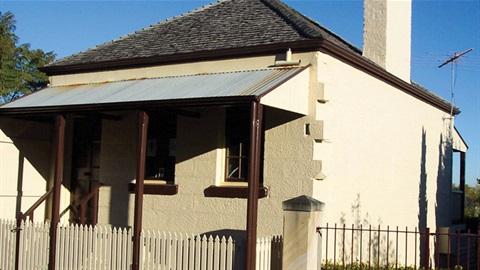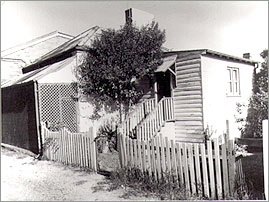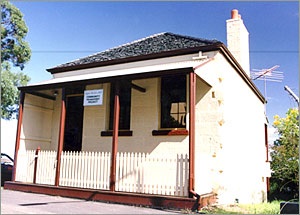Westward Cottage

Located at: 8 Turner Street, Ryde
Westward lies close to the heart of the historic village of Ryde. It is a nineteenth century single storey cottage built in brick with a sandstone facade and footings. The building is of a type usually described as a 'workman's cottage' and is significant as the only surviving domestic example of the earliest phase of urbanization in Ryde.
Birth of a village: The first move towards the formation of a township at Ryde took place in April 1841 when local landowners James Shepherd and James Devlin offered a number of building lots for sale at public auction. Devlin's subdivision was near St. Anne's church.
Announcing the sale in the Sydney Herald, the auctioneer advised prospective buyers that they would be delighted by the sight of the pretty little church on a Sunday when "the whole village meet together, with their best faces, and in their cleanliest habits, to hear their duties explained to them by their good pastor, the Rev. Mr. Turner". Other advantages were "an excellent school for the education of children", "a police establishment for the protection of property" and "Mr Manning's beautiful steam boats" which went by four times a day on the Parramatta River.
A plan prepared for the auction was titled Plan of the Village of Ryde Kissing Point N.S.W. 1841 and is the earliest reference to the name Ryde for this area. Ryde on the Isle of Wight had been the home of Mary, wife of the Rev. George Turner, and also George Pope, Kissing Point's first postmaster. Turner Street, created by the subdivision, was so named in honour of the parson.

The township of Ryde was slow to develop. A plan dated 1866 shows the scattering of buildings which made up the village at that time. Close to the village is James Devlin's mansion house Willandra. At a little further distance is the watch house and Thomas Kendall Bowden's house Addington. All three buildings still exist. The watch house continues to serve as a police station while both Addington and Willandra have been restored by Ryde Council and are used for community purposes.
Of the other buildings shown in the plan those that are still standing are St. Anne's church and two buildings fronting Turner Street. One is the former Wesleyan chapel built in 1848 and now a Uniting Church hall. The other is a building that might be Westward in the middle of Turner Street.
Construction
Bidders at Devlin's 1841 auction were reminded that land was a desirable capital investment, even in difficult times. Buyers were offered free access to whatever building materials they might need from Devlin's land adjoining the subdivision. This included stone, loam, brick-earth, water and wood to burn bricks.
All Devlin's lots were sold at the auction, but few were built on immediately. Lot 16, the Turner Street lot on which Westward was originally erected, sold to Henry Edmondson, a Sydney tailor. But by late 1843 Edmondson, feeling the effects of the severe economic depression which hit New South Wales in the 1840s, had in turn sold lot 16 to Henry Murray a local Kissing Point carpenter.
Henry Murray's Cottage
Henry Murray emigrated to New South Wales from Dublin in October 1840 aged 24. He was living at Kissing Point by January 1842 when he married another Kissing Point local, Margaret Bethel.
Murray set up in business as a builder and in 1844 advertised in the Sydney Morning Herald, offering 'liberal wages' for a 'first- rate joiner'. He may have worked on James Devlin's new house Willandra which was being built at that time. But, like Devlin himself and so many others at the time, Henry Murray went bankrupt. In 1849 he was forced to sell his land in Turner Street, including his unfinished two-room weatherboard cottage, to Sydney timber dealer George Head.
In 1852 Head sold the land to George Porter a farmer of North Ryde. Porter was acting as trustee for Henry William Watts, then 10 years old and the son of Porter's half-sister Sarah Watts.
Henry Watts' Cottage
The building materials and construction methods of Westward suggest that the present cottage was built in the 1850s, re-cycling timber from Murray's original building. The dressed stone facade, 12-pane double hung windows, 6-panelled front door with fan light and the stone step, worn down over time, are all indicators of an 1850s building.
Henry Watts did not live in the cottage in Turner Street. He owned an orchard and vineyard called Belmore on North Road Ryde, adjoining Watts Road. He served as an alderman on Ryde Council and was Mayor from 1886 to 1887.
Westward's Tenants
Westward was rented throughout the nineteenth century to a succession of tenants. Perhaps the first of these were Frank Wilson and his family. Wilson was a stonemason who came to Ryde in the early 1850s to work on the building of St. Charles Catholic Church. He is believed to have lived in Westward before building his own sandstock brick cottage in Church Street.

Another stonemason named David Hartland is reported to have lived in the cottage in 1884 while he was engaged in the construction of the Wesleyan parsonage in Turner Street. A later tenant, Otto Junge, operated a laundry at Westward from around 1888 until 1893. Other residents in the street around that time worked as day-labourers for Ryde Council. It was perhaps from this era that the street earned a reputation as a cock-fighting venue.
When Henry Watts died in 1918 his daughter Jessie Elizabeth Taylor inherited the property in Turner Street. It was Jessie who named the cottage Westward, inspired by the beautiful view to the Blue Mountains and the lovely sunsets seen from the back of the house. She lived in the cottage until her death at the age of 97 in 1965. Her daughter Lennie continued to live there until 1978.
Plans for the construction of the Devlin Street underpass threatened the cottage with demolition in 1989. Ryde Council chose instead to dismantle Westward and relocate it a little further along Turner Street, reconstructed in 1993 as an 1850s cottage.
It now operates as part of the Macquarie Community College's Adult Education network, under a lease with the City of Ryde.
Current Condition
This building was relocated, restored and renovated as part of the road works associated with the Victoria Road grade separation. Westward Cottage had been the subject of various unsympathetic additions over the years and had deteriorated over time. Works undertaken also included thematic landscaping to link it with the adjoining The Parsonage together with the establishment of detached disabled toilet facilities.
Although presently in good condition, the building requires a program of works to maintain its condition that will need to include future roof treatment and the implementation of a conservative works program.
Written by Megan Martin, former Local Studies Librarian, Ryde Library & Information Services. July 1994.